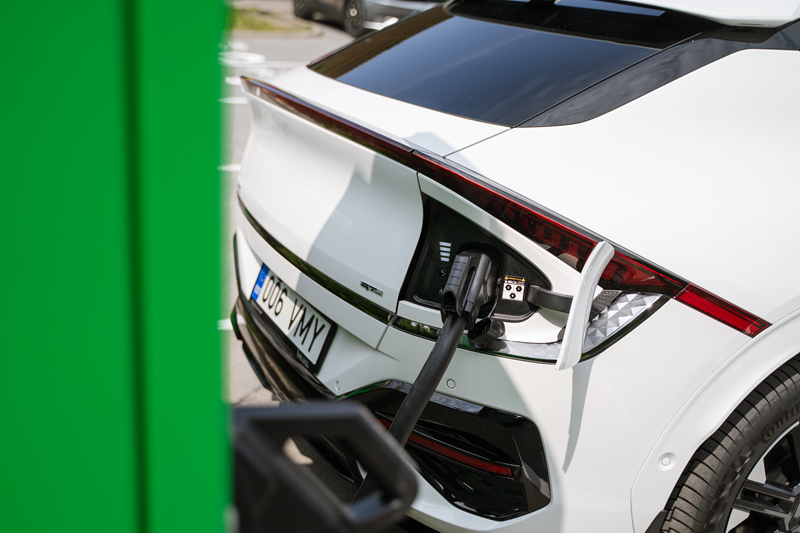The exchange price of electricity has decreased to a reasonable level. Natural gas is more expensive than a few years ago, but still at a tolerable price compared to the past year. What energy prices will look like in the coming winter will largely depend on what the upcoming summer will be like.
| Price zone | Average exchange price | Change (previous week) |
| Estonia | 64.5 €/MWh | +60,6% |
| Latvia | 64.5 €/MWh | +60,6% |
| Lithuania | 66.1 €/MWh | +55,4% |
| Finland | 61.8 €/MWh | +64,5% |
Last week the electricity price in Estonia was on average 64.5 €/MWh (+24.4 €/MWh compared to the previous week). Electricity was the most expensive last Monday morning at 9:00, at which time the price was 172.98 €/MWh. The cheapest hourly rate was on Sunday 23 April at 15:00 in the afternoon, when the cost of a megawatt hour was 5 euros.
The most important event of the Baltic electricity system took place last week in Lithuania, when the country’s transmission system operator Litgrid carried out a decoupling test, during which the electricity system was disconnected from the electricity system of Russia, Belarus and Latvia for ten hours. The decoupling test did not cause any disturbances in the Estonian electricity system – according to Estonian electricity system operator Elering, the security of supply was ensured throughout the test.
The joint decoupling test of all three Baltic countries is planned for no later than 2025, ie after all the investments required for synchronisation with the electricity system of continental Europe have been completed. By January 2026 at the latest, the Baltic countries must be disconnected from the Russian electricity system and connected to the frequency band of continental Europe. As we remember, after being attacked by Russia, Ukraine hastily reconnected to the European frequency network in February 2022. The frequency band of Europe is more than twice as large, and the possibility of maintaining frequency in the Russian band was significantly reduced with Ukraine’s departure.
The price of natural gas will rise again in autumn
People across Europe are awaiting next winter with concern. According to current forecasts, the reduced nuclear energy production means that electricity in France will be twice as expensive as in Germany. The difference between the electricity prices of the two countries is estimated at nearly 250 €/MWh, because energy traders want to protect themselves from risks posed by the aging and malfunctioning nuclear power plants of the French energy giant Electricite de France. While the trading price in the first quarter of 2024 in France will be 416 €/MWh, it will be 169 €/MWh in Germany. The French, who have been exporting energy for decades thanks to nuclear power plants, became importers last winter, and dependence on neighbouring countries will certainly continue this year.
Germany shut down its last nuclear plants on Saturday and remains dependent on polluting coal energy. At the same time, the rise in the proportion of renewable energy will lead to an increase in weather-related price volatility.
Meanwhile, Hungary is trying to extend the service life of its only nuclear power plant by 20 years in order to cover the gap caused by delays in the expansion of the plant. In 2014 the Hungarian government, led by Viktor Orbán, ordered the expansion of the Paks Nuclear Power Plant, which covers 40% of the country’s electricity consumption, from Russian state-owned company Rosatom, but the ten billion euro contract has not managed to ensure the timely completion of the plant. The service life of the four reactors of the nuclear power plant launched in 1982 has already been extended once before, and according to current plans, the last of the old production units should be closed in 2037.
The average weekly gas price was 41 €/MWh (−1.6 €/MWh compared to last week). Warmer weather will continue to keep gas prices down, but there are many different scenarios proposed for next year. According to analysts, the European Union will be able to restore its gas stocks to the target level of 90% by late August or early September, instead of the initial goal of November. Optimism ahead of the coming winter is boosted by recent Eurostat data showing that the European Union managed to reduce its consumption of natural gas by nearly 18% in the eight months preceding March compared to the five-year average. The official target of the EU was 15%. Gas consumption was reduced the most in Finland (–55.7%), Lithuania (–40.5%) and Sweden (–37.2%). In March the EU decided to extend the 15% target until March 2024, while having maintained the level of stocks at 57.6% This is twice as much as at the same time last year.
On the other hand, German-based lobby group Ines warns that in the event of an extremely cold winter, the country’s gas stocks may be fully depleted by January. According to the forecast of Ines, Germany could reach a 95% capacity by 1 November, but it would be difficult to maintain the stocks at 40% by February in the event of cold weather, and in the case of a normal winter, they would be completely depleted by the end of March. Germany’s gas storage facilities are currently at around 64% capacity. Ines emphasises that filling storage facilities is crucial for the coming winter, but consumption must be significantly cut when it gets cold, as security of supply has not been restored after the supply of Russian pipeline gas dried up. According to the calculations of the consultancy company Ganexo, Germany’s storage facilities can hold 250 TWh of natural gas, but despite reducing consumption by nearly a quarter, demand totalled 530 TWh last winter, which leaves the country heavily dependent on imports. At the same time, as many as six new LNG terminals should be completed in Germany by the end of next year, which will make gas imports significantly easier.
According to analysts who spoke with Montel, the market price of natural gas will remain at its current level until September thanks to stocks and LNG imports in Europe, but will then start to increase due to intensified international competition and winter-related supply risks. The price of the Dutch gas exchange TFF has decreased by half this year, but is still twice as high as the average of 2016–2021. The price dropped to 39.40 €/MWh last Thursday, but transactions for September cost 44.23 €/MWh and for winter 55.30 €/MWh. According to analysts, rapid restoration of stocks and launching joint procurements of the European Union could bring relief to the exchange price.
The rapidly growing volume of solar production is creating surprises in the European market
In the Netherlands, the price of electricity was below zero for a few hours last week, dropping as low as –739.96 €/MWh. This was caused by the large amount of solar energy supplied to the grid, which significantly exceeded demand and export capacity. Overproduction of green energy also occurred in Poland, where the country’s transmission system operator ordered the reduction of renewable energy over the weekend to ensure the balance of the electricity system. Both countries have installed numerous solar panels in the past year.
The Copernicus Climate Change Service warns that the severe droughts that hit Europe last summer will become common in the coming years. According to researchers, the amount of water in Europe’s rivers has been steadily decreasing over the past six years, agricultural lands are drier and Alpine glaciers are shrinking. The change causes a negative feedback loop where warmer temperatures accelerate the melting of glaciers, less rainfall reduces the water level of rivers and dried vegetation creates the conditions for fires. This will further lead to a higher demand for fuels, as the use of rivers for transport and energy production will decrease, and commerical and residential premises will have to be cooled in summer.
Many nuclear power plants also had to cut their production last year, as they had too little or too warm cooling water. As river levels may also be too low to transport coal in the future, putting gas power plants into operation will be inevitable. This will in turn consume valuable gas, which is required for the winter period. In such a scenario, gas prices would certainly climb higher before winter than what is currently predicted.
Last week, Danish police arrested eight employees of an energy trading company suspected of manipulating the Nordic electricity exchange to make illegal profits. The manipulation has allegedly generated income amounting to tens of millions of euros between 2021 and 2023. It is suspected that the manipulation consisted of reserving transmission capacities on the market which were not actually used, thus influencing market prices.
The average weekly price of CO2 was 92.9 €/t (–2.8 €/t compared to the previous week), dropping slightly due to lower than expected demand.
The Eesti Energia Narva stations provided up to 145 MW to the market last week. The third energy block of the Eesti power plant is undergoing maintenance until May and the fourth energy block is undergoing annual maintenance until September.
The price of electricity is formed per hour based on the exchange price, depending on the production capacity and consumer demand in each particular hour, as well as interstate limitations on transmission capacity.
Olavi Miller, Market Analysis Strategist at Eesti Energia
The market overview has been compiled by Eesti Energia according to the best current knowledge. The information provided is based on public information. The market overview is presented as informative material and not as a promise, proposal or official forecast by Eesti Energia. Due to rapid changes in the regulation of the electricity market, the market overview or the information contained in it is not final and may not correspond to future situations. Eesti Energia is not liable for any costs or damages that may arise in connection with the use of the information provided.



